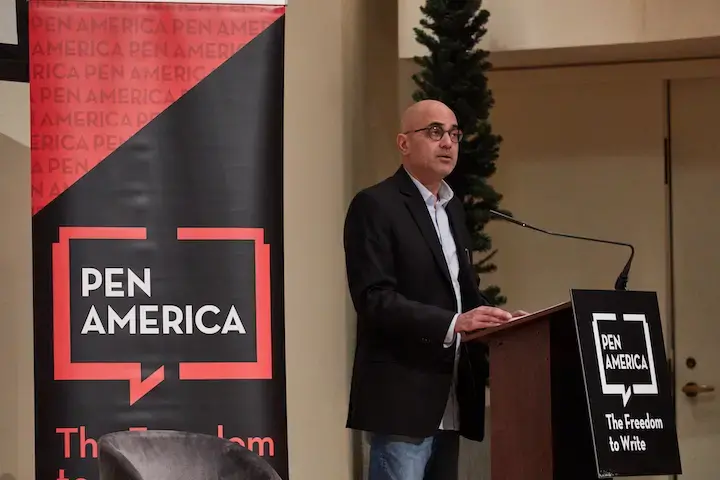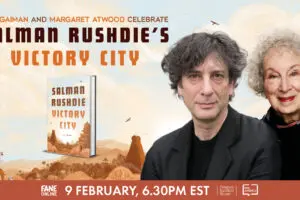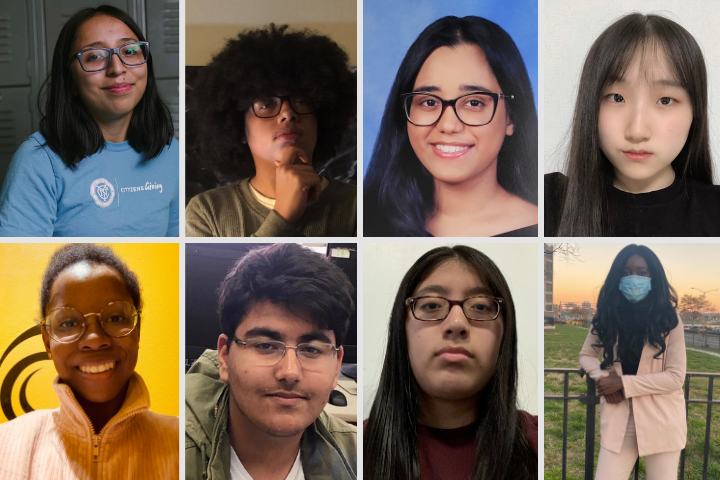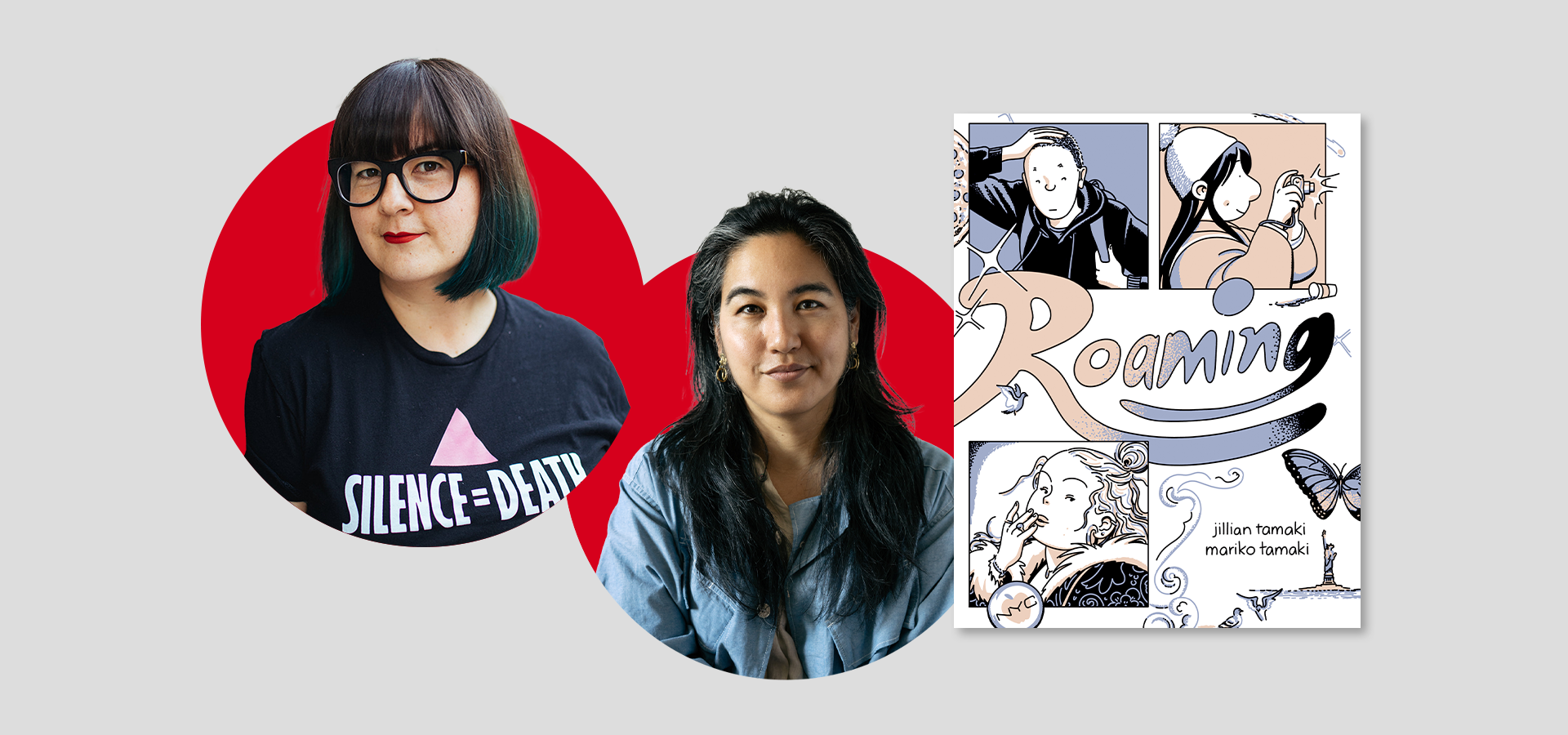
Jillian Tamaki & Mariko Tamaki | The PEN Ten Interview
September 7, 2023
Jillian Tamaki and Mariko Tamaki’s new graphic novel Roaming follows old friends Dani and Zoe reuniting over their college spring break on a trip to New York City. Joining them is Dani’s new classmate Fiona. A beautiful look at how friendships grow and change, the novel follows the three friends as they traverse a gorgeously illustrated 2009 version of New York City. Old friendships are tested and a new romance blossoms as the trio shop and sightsee their way across the city.
In conversation with World Voices Festival Associate Director, Sabir Sultan for this week’s PEN Ten, Jillian Tamaki and Mariko Tamaki speak about their collaboration, share their process for researching New York City in 2009, and highlight some of the interpersonal dynamics in Roaming they explore. (Barnes & Noble, Bookshop)
1. Roaming is the third collaboration between the two of you, following your 2014 Eisner winning graphic novel This One Summer and your first collaboration SKIM. What was it like to work together after so many years? How was your collaboration on Roaming different from your prior collaborations?
Mariko Tamaki (MT): We’ve always had a knack for knowing when to start up a new project. We don’t really have an imperative to work together, so when we start something new it’s because we’re both excited to work together. I guess some time around 2018 or so we started bouncing around various ideas, and then Jillian emailed me with this book she’d started working on that she said felt like something we should do together. Roaming is the first collaboration we’ve ever done that we worked on and wrote together from the beginning, which makes it feel very special and very much like the next step in our creative process.
2. The transition to college marks a period of transformation for young adults as they learn themselves anew in new contexts. In one of my favorite sequences, after a fight, Zoe and Dani are illustrated as their high school selves while their conversation continues in the novel’s present day. As high school best friends, Dani and Zoe know each other, but after a semester apart there are new sides to each of them the other has to learn. What did you want to capture about loving someone you no longer know as completely as you once did?
MT: It’s a bit of a running joke/accurate statement that all of our work is a sort of meditation on the trials and tribulations of growing up. Part of how you know you’re growing up is seeing the connections you have with the people in your life change. For whatever reason, Jillian and I seem to be deeply invested in how that manifests in friendships. I think because it’s so foundational; your first big break up, the first loves of your life, are your friends. Those stories are really interesting, meaty stories.
“For whatever reason, Jillian and I seem to be deeply invested in how that manifests in friendships. I think because it’s so foundational; your first big break up, the first loves of your life, are your friends.”
3. As first time tourists in New York, Zoe and Dani are excited to visit all of the spots they’ve dreamed of – The Metropolitan Museum of Art, The Flatiron Building, etc. How did you pick their must-see spots?
Jillian Tamaki (JT): The choices were usually based on if they were fun to draw and if they made sense in terms of “could these girls actually walk there by the afternoon?” I envisioned every New Yorker getting irritated if they were at the Bronx Zoo then Times Square then Prospect Park then the Flatiron. Also, they’re there to see “the hits.”
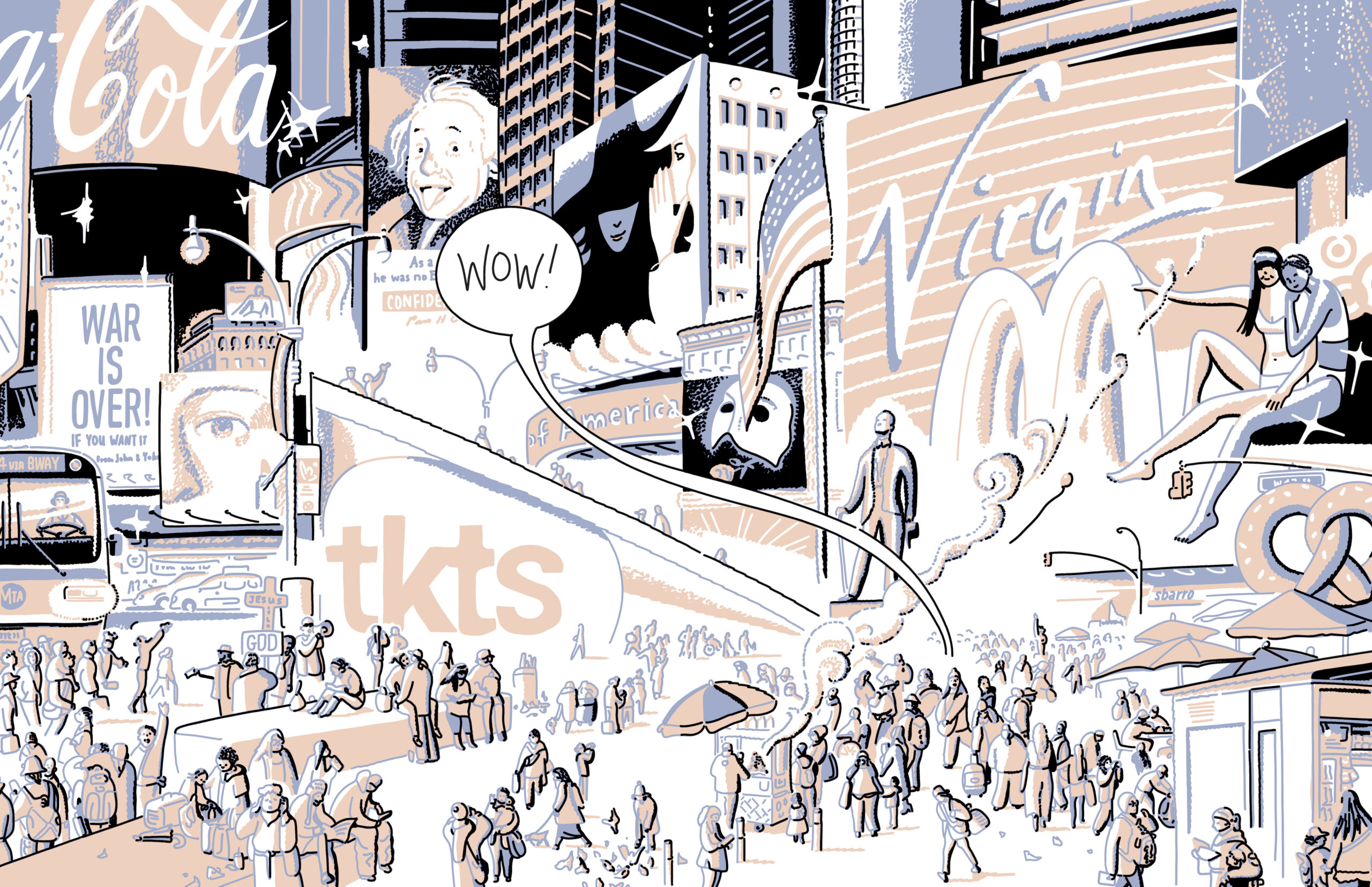 4. The graphic novel is set in 2009 and small details throughout the book, from the now-closed Virgin Records Megastore in Time Square to the characters’ excitement over their first trip to a Uniqlo, embed the story in the specificity of 2009. How did you go about researching New York in 2009? Why was it important to you to have that level of verisimilitude?
4. The graphic novel is set in 2009 and small details throughout the book, from the now-closed Virgin Records Megastore in Time Square to the characters’ excitement over their first trip to a Uniqlo, embed the story in the specificity of 2009. How did you go about researching New York in 2009? Why was it important to you to have that level of verisimilitude?
JT: There was extensive research involved! Due to COVID, I was unable to go to NYC, as I originally intended to take reference photos. That was what I had done with previous graphic novels. However, even if I had been able to, the city has changed so much. So the Lower East Side of 2021 wouldn’t have looked like it did in 2009 anyway.
Because it’s New York, every square inch has been documented and uploaded. Youtube, Google Streetview (especially the archive feature), and Flickr were very important. Flickr in particular, since 2009 was its heyday and a lot of images were uploaded around that time. Flickr photos have the added advantage of being from a “first person point of view,” photos on Google image search typically are more stock or commercial images.
I do like to recreate the real world in miniature. The challenge for the book was to portray the city as it appears to a tourist, but with a level of thoroughness that a local would recognize. Or, at least, not take issue with.
“I think class is going to be present in most work, explicitly or implicitly. Especially if you are attempting to depict “the real world” in any way.“
5. At the center of the story is a non-traditional love triangle. Zoe and Dani love each other platonically. Enter Dani’s college acquaintance Fiona, who becomes involved with Zoe romantically and pulls Zoe’s attention away from Dani and their long awaited trip to New York. How did you want to subvert or use the dynamics of the love triangle trope in Roaming?
MT: I don’t think our goal was to subvert the standard love triangle so much as explore the many ways a vacation involving three people can go horribly wrong. Really what happens to Dani, Zoe, and Fiona is more about the dynamics of three, the frictions and subtle power struggles that take place when you have friends with different connections and relationships.
6. You do a beautiful job of capturing Zoe at the nascent point of coming into and claiming her queer identity, from the aesthetics of her newly cropped short hair and uniform of a black hoodie and jeans to her initial shock and then gentle acquiescence when Fiona tells her, “You have that cool dyke thing going on.” What about that period of queer development was important to you to capture on the page?
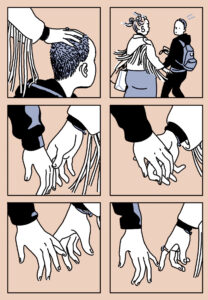 MT: It was fun to explore the character of Zoe and give her all these specifics of a “new” queer identity. Queerness with a capital “Q” is such a big, complicated thing and at the same time something as simple as shaving your hair off can have so much meaning. We tried to have a pretty light touch about it and stay in specifics because Zoe is not in a place where she has big statements to make about her sexuality or gender. She’s just trying to move towards something that works for her and it was such a lovely part of Roaming to tell that story.
MT: It was fun to explore the character of Zoe and give her all these specifics of a “new” queer identity. Queerness with a capital “Q” is such a big, complicated thing and at the same time something as simple as shaving your hair off can have so much meaning. We tried to have a pretty light touch about it and stay in specifics because Zoe is not in a place where she has big statements to make about her sexuality or gender. She’s just trying to move towards something that works for her and it was such a lovely part of Roaming to tell that story.
7. A subtle thread throughout the book is the difference in financial resources between Zoe and Dani. Dani is able to put the hostel room charge on her credit card and regularly purchases items while shopping, meanwhile Zoe determined where to go to college based on scholarships and is desperately concerned about incurring roaming charges on her cellphone. Why was it important to you to bring in that element of class difference? Particularly in the context of traveling abroad, which in itself requires a certain amount of privilege?
JT: I kinda think Zoe’s just cheap. She’s the one with the iPhone in 2009!
But yes, it requires a degree of privilege to travel – even cheaply. It’s a middle to upper-class experience and I think the girls’ background is reinforced when we get a glimpse into where they come from.
I think class is going to be present in most work, explicitly or implicitly. Especially if you are attempting to depict “the real world” in any way.
8. In Roaming the characters navigate different relationships with their bodies, whether it’s Dani’s physical insecurities as she tries on clothes in a changing room or Fiona breezily changing in front of Dani and Zoe. The characters’ bodies have a presence through illustrations such as Dani on the toilet forlornly searching for toilet paper or Zoe brushing her teeth with her towel wrapped around her waist. How do you approach depicting characters’ bodies? Why was it important to bring forth characters’ relationships to their bodies?
JT: Body language has always been a big part of my storytelling, within my collaborations with Mariko and my solo work. Characters’ mannerisms and ways they carry themselves add so much information about who they are. Plus I think it’s one of the most fun aspects of comics-making. It really makes the character come to life – no dialogue necessary. Sometimes writing is privileged over art in comics, but both contribute so much to the story together and separately.
“Body language has always been a big part of my storytelling, within my collaborations with Mariko and my solo work. Characters’ mannerisms and ways they carry themselves add so much information about who they are.“
9. Much of Roaming was written and created during the pandemic. What was it like to write a book about three friends traveling as tourists while you yourselves were in lockdown?
JT: It was definitely surreal. At the beginning of the pandemic we really didn’t know if we would ever be able to travel again. I had set out to make an energetic, joyous book, and to be honest, I really wasn’t feeling those emotions for most of 2020. So I put it aside and worked on other things, even though we had already sold it to a publisher. I couldn’t tap into the right mindset. I really believe that a lot of yourself gets transmitted to the work subconsciously and it wouldn’t have served the story.
Of course, now, travel is on a major upswing. I think we are right to be debating tourism’s effects and consequences.
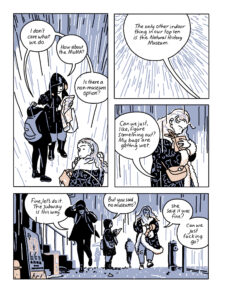 10. Which writers working today are you most excited by?
10. Which writers working today are you most excited by?
MT: I’m a huge fan of Lee Lai. Loved Stone Fruit. Can’t wait to see what’s next. I was also just talking about Hiromi Goto and Ann Xu’s Shadow Life, which I think about all the time. Would love to see more stories like that in the world.
Jillian Tamaki is a cartoonist, illustrator, and educator raised in Calgary, Alberta. She is the author of the Eisner Award-winning graphic novels SuperMutant Magic Academy and Boundless, and the author-illustrator of two picture books, including most recently Our Little Kitchen. With her cousin Mariko Tamaki, she is the co-creator of the young adult graphic novels SKIM and This One Summer, which won a Governor General’s Award and Caldecott Honor. She lives in Toronto, Ontario.
Mariko Tamaki is a Canadian writer living in California. She is the co-creator of the graphic novels SKIM and This One Summer with Jillian Tamaki, and Laura Dean Keeps Breaking Up with Me with Rosemary Valero-O’Connell. She writes superhero comics for DC Comics, Darkhorse and Marvel. Mariko was the recipient of the Eisner for Best Writer in 2020. Collectively, her works have received Printz Honors, Eisner, Ignatz, Ringo and Prism awards. She is the curator of the Abrams LGBTQ imprint, Surely Books.
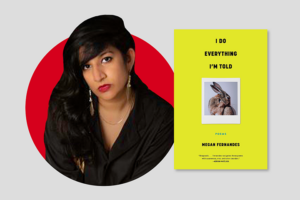
Megan Fernandes | The PEN Ten Interview
My focus was just on the insecurity of being. Everything that happened narratively came from focusing on that feeling as much as possible.
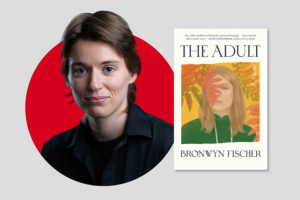
Bronwyn Fischer | The PEN Ten Interview
My focus was just on the insecurity of being. Everything that happened narratively came from focusing on that feeling as much as possible.
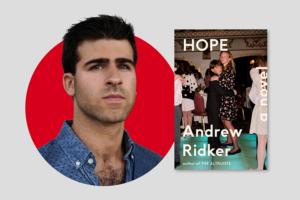
Andrew Ridker | The PEN Ten Interview
By: Anna Lasek | August 17, 2023
In a way, the structure of the novel reflects one of its primary themes: the desire to break away from one’s family, and the bonds that invariably pull one back.
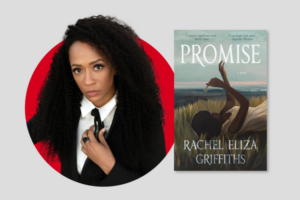
Rachel Eliza Griffiths | The PEN Ten Interview
By: Malcom Tariq | August 11, 2023
This book was my attempt to assure young Black girls that there are beautiful, resonant ways to live, to investigate love, and to celebrate themselves.

